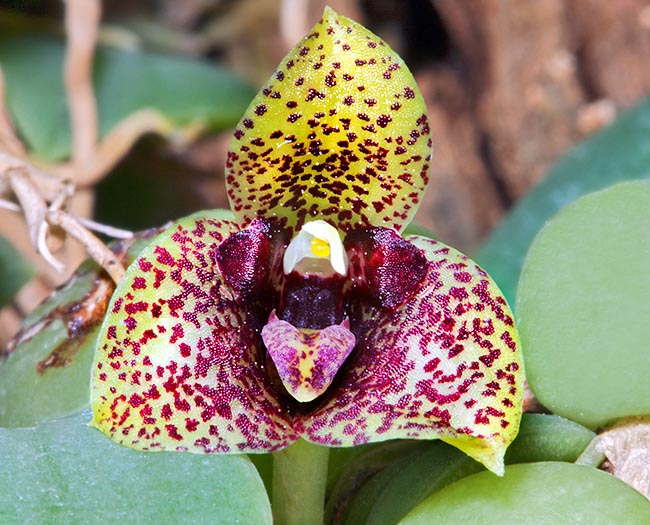Family : Orchidaceae

Text © Pietro Puccio

English translation by Mario Beltramini

The weird flower of this epiphytic orchid is less than 2 cm. A small jewel for lovers © Giuseppe Mazza
The name of the genus is the Greek term “trias” = triad, with reference to the three sepals arranged in a triangle; the name of the species is the Latin term “pictus, a, um” = painted, with obvious reference.
The Trias picta (E.C.Parish & Rchb.f.) C.S.P.Parish ex Hemsl. (1882) is an epiphytic species with short creeping rhizome from which originate, spaced of about 1,5 cm, ovoid pseudobulbs of 1-1,5 cm of diameter, equipped at the apex with one only fleshy, oblong-elliptic, leaf with pointed tip, about 6 cm long and 0,7-1,5 cm broad.
Inflorescences 2-2,5 cm long from the base of the pseudobulb carrying only one yellowish flower, or dotted with cream and suffused with purple, of 1,2-1,8 cm of diameter; the single flowers last 1-2 weeks. The sepals are ovate-triangular, 1 cm long and 0,6 cm broad, the two lateral united at the base of the column to form a sort of a spur (mentum) about 0,5 cm long, the petals are obovate or emarginate (from the apex having a shallow notch), 0,4 cm long and 0,3 cm broad, at the sides of the column, the labellum is obovate, 0,4 cm long and 0,2 cm broad, slightly wrinkly on the upper side. It reproduces by seed, in vitro, and by division, with each section provided of at least 3-4 pseudobulbs.
Mini-orchid, floriferous and of easy cultivation, it requires medium-high temperatures with values, in winter, not lower than 15 °C, a shaded position and constant, high, humidity, 70-80%, the whole year round, with air in constant movement. It does not have a precise resting period, the waterings, therefore, must be regular, but it is wise to slightly reduce them in winter, without, however, allowing them to dry up completely, when average temperatures are lower.
For the waterings and the nebulisations, it is to be utilized rainwater, or by reverse osmosis or demineralised; the fertilizations, duly distributed and alternated, in way to avoid salts accumulation at the roots, are to be done during the vegetative period preferably with hydro-soluble balanced products, with microelements, at ¼ of the dosage suggested on the packaging. It is to be mounted, preferably, on trunks, bark, cork raft, possibly with some sphagnum in contact of the roots for maintaining the humidity; it does not appreciate to be disturbed, therefore transplants and divisions are to be done, by the vegetative restart, when strictly necessary.
The species is reported into the appendix II of the CITES (species whose trade is internationally ruled).
Synonyms: Bulbophyllum pictum E.C.Parish & Rchb.f. (1874); Trias picta (Parish & Rchb. f.) Rolfe (1888).
→ For general notions about ORCHIDACEAE please click here.
